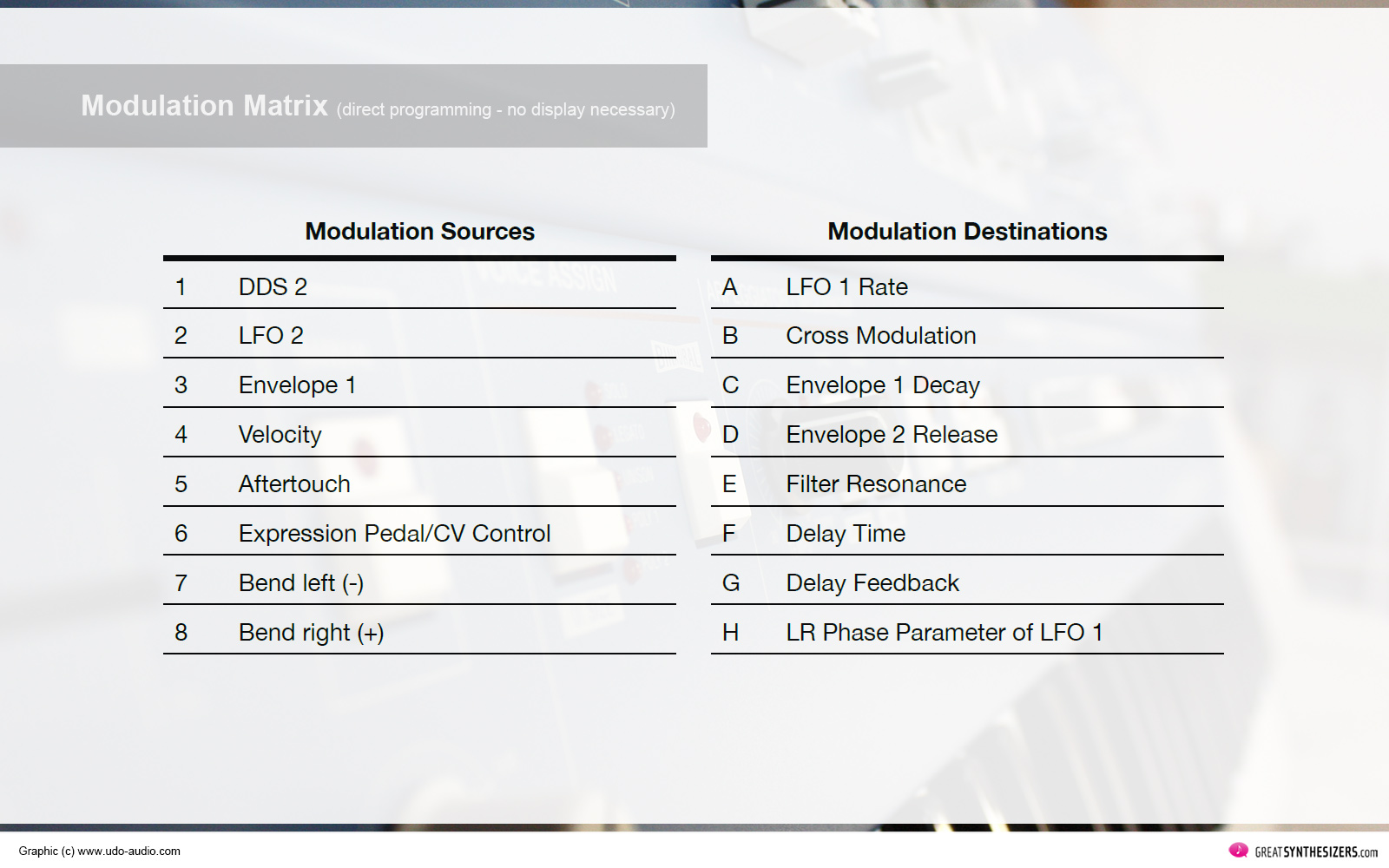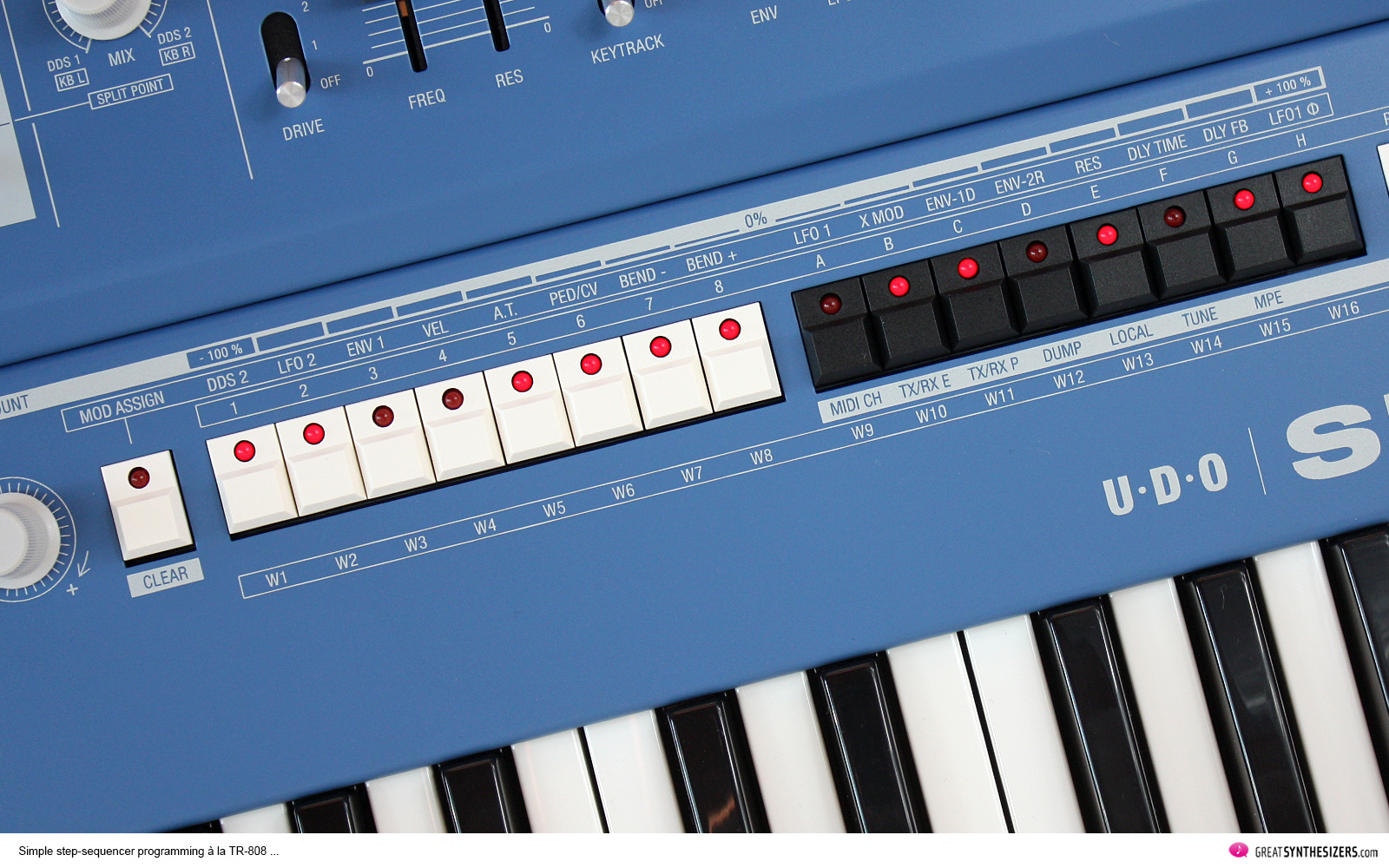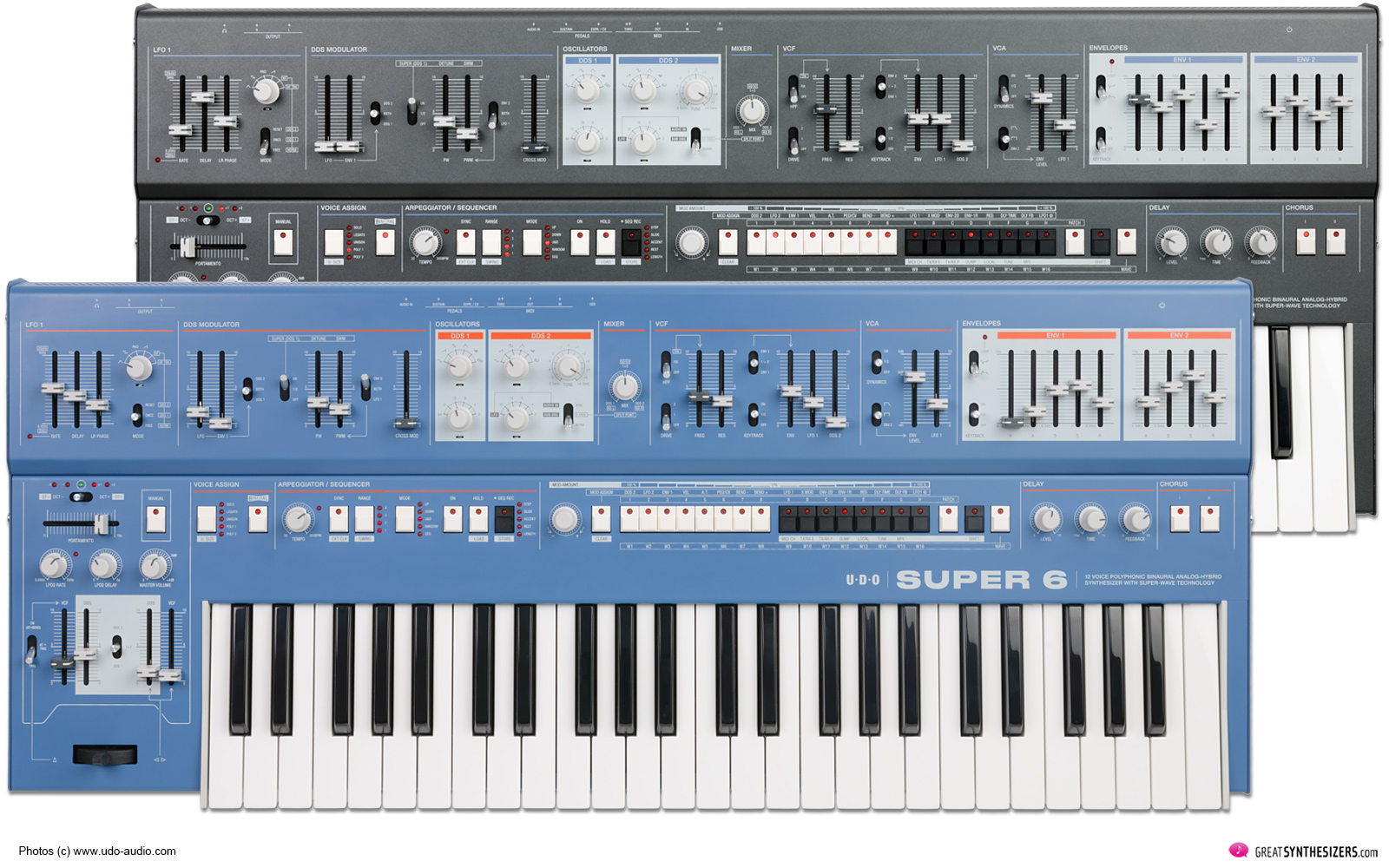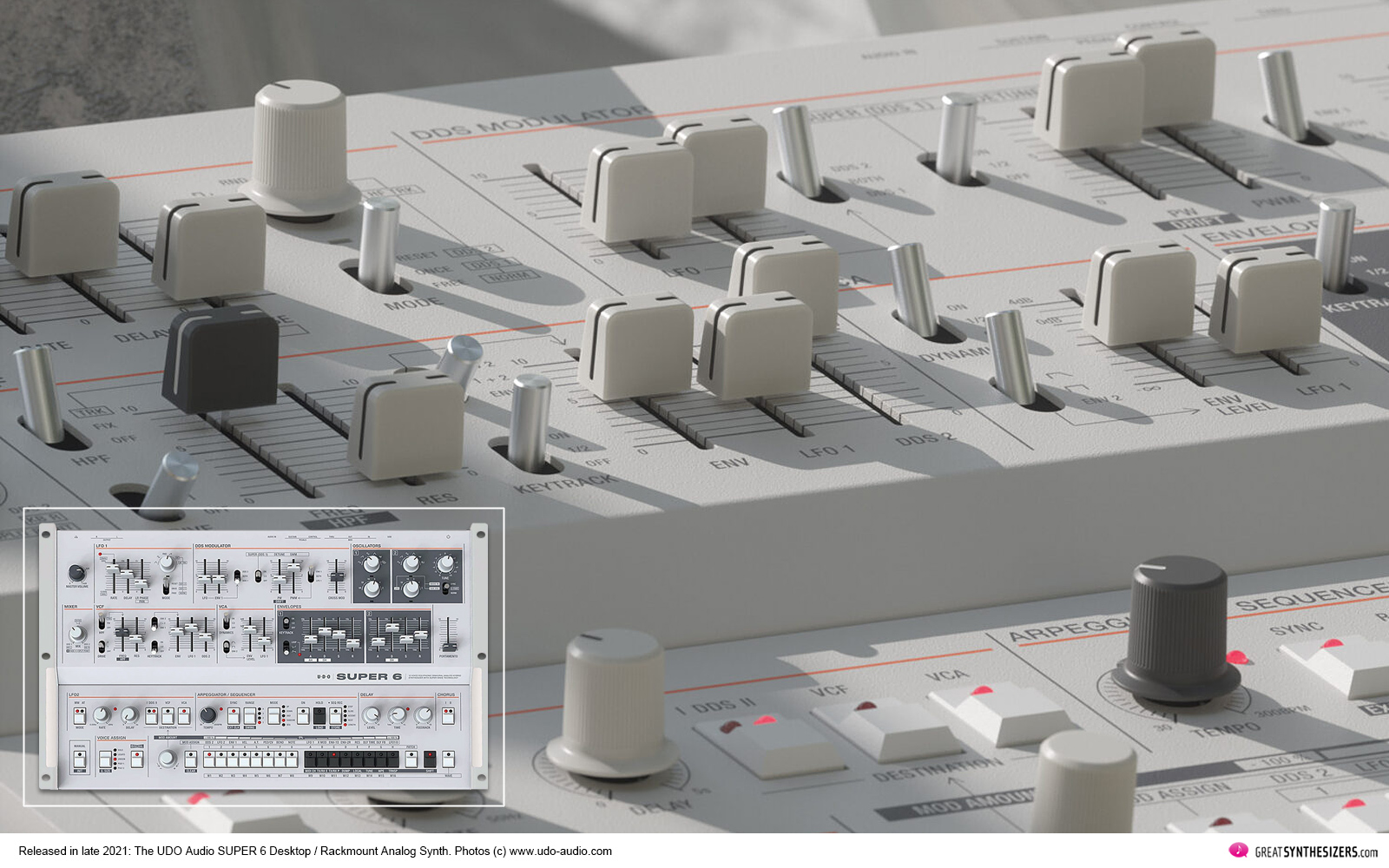UDO Audio SUPER 6, reminiscent of some of the great synth classics from the late 70s and early 80s, cleverly combines synth features of today with those of past decades. It is an acoustical chameleon, a carefully designed, solidly built instrument that studio musicians and sound designers probably already have written in gold on their secret MUST-HAVE lists …
The SUPER 6: A very special synthesizer from England, developed by George Hearn and his UDO team in Bristol, designed (Axel Hartmann) and manufactured in Germany. A real international.
This synth inspires beyond measure. Chorus pads à la Elka Synthex, warm strings with BandPass filter sweeps, strong unison textures, vivid modulation movements and FX noises, sequencer- and arpeggio-sounds of all kinds. Plus heaps more. Surprise! In combination with its step sequencer, SUPER 6 also functions as a terrific analog drum computer. Surprise, surprise! The instrument is capable of sound impressions / sound qualities normally possible only on a PPG Wave 2.2 / 2.3. Which is a bit of a phenomenon to us, since SUPER 6 has no wavetables. But its extra waveforms and strong SSI2144 VCFs add up to great hybrid / PPG-like sounds. And then there is that shade of a Sequential Prophet VS, too.
Convincing sound is often a product of well-thought-out technology. So we have to start at the beginning. First, a few technical terms. These will help us describe the UDO Audio SUPER 6’s inner core …
FPGA, DDS, BINAURAL and SUPER Mode
The SUPER 6 sound architecture is based on digital oscillators with enormous computing power, stemming from ICs of the FPGA class. Now, FPGA stands for Field Programmable Gate Array. Can we agree on that? Great. If you did frown (which is probably your own fault), please study this chapter for more information.
The SUPER 6 FPGA-based signal-generation method has a specific name: DDS – Direct Digital Synthesis. Which describes the immediate calculation of the desired waveform at ultra high-frequency range (50 MHz). This allows convincingly real emulations of analog waveforms and digital, glassy waveforms (“PPG sound”).
With this enormous computing power it is also possible to create 6 secondary oscillators in parallel to the main oscillator DDS 1. These are distributed in the stereo panorama and may be detuned against the main oscillator, a phenomenon known as SUPER Mode / SUPER Waveform.
At this point, let’s let UDO Audio have their say:
“Direct Digital Synthesis is the signal generation method employed by both oscillator cores of the Super 6. At its centre is a clock signal – three orders of magnitude higher than typical audio sample rates. The clock signal increments a counter through thousands of indices in your choice of waveform, selecting the appropriate sample to output every twentybillionths of a second with interpolation filling in the gaps between samples at different oscillator frequencies. The samples produced by our numerically-controlled oscillators are then transformed to analog voltages by a DAC, one for each oscillator, which operates at the same clock rate before being filtered by a preliminary analog low-pass filtering stage.”
(Source: UDO Audio SUPER 6 Manual, page 10)
The digital oscillators are complemented by an analog signal path consisting of VCF and VCA. Which is, up to hear, a traditional (hybrid) voice architecture …
But SUPER 6 goes further. It offers two signal paths (with control of the left-right channel-phase relationship > stereophonic audio-panning), two filters on each side, a dual effect section and more.
In its classic MONAURAL mode (one sound at a time), SUPER 6 is a 12-voice polyphonic synthesizer. Pressing the BINAURAL button, however, turns the instrument into a 6-voice machine with two sounds each, providing a wide stereo image …
“In Binaural mode, the Super 6 features a true stereo signal path in which the instrument’s twelve voices are twinned to form six stereo ‘Super’ voices. Consequently, the left and right channels — and each of the player’s ears — are assigned their own complete synthesizer voice. Parameters for both channels of each super voice may be independently controlled, facilitating the player to create rich and unique stereo images.”
(Source: www.udo-audio.com)
So, that’s what the SUPER 6 is all about: a single-sound engine with 12 voices, or a double-sound engine – that magic BINAURAL mode – with 6 voices. Now enough of these technical descriptions. Let’s turn to the instrument’s …
SOUND Architecture
The SUPER 6 consists of:
- LFO 1 (Low Frequ 0,05 – 20 Hz / High Frequ 20 Hz – 20 kHz) with one-shot function
- LFO 2 (0,05 – 50 Hz, Mod-Lever / AT), to be found in the performance section
- DDS 1 (Oscillator 1), standard waveforms plus noise and 16 extra waves
- DDS 2 (Oscillator 2), standard waveforms plus noise and PWM, can be switched to LOW frequ / LFO mode
- 24dB LowPass VCF with HighPass Filter that can also track the low-pass filter
cutoff frequency for band-pass operation - ADSR 1 for VCF, with HOLD and LOOP function, VC decay (!)
- ADSR 2 for VCA, VC release (!)
Additional details:
- Comprehensive oscillator modulations (PWM, sync, cross mod, super mode, etc.)
- 16 extra waves (DDS 1) that can be replaced by your own waveforms
- A strong performance section (LFO 2, pitch bender, mod lever), keyboard (VEL + AT)
- Different Voice Assign Modes (Poly, Solo, Legato, Unison)
- Arpeggiator (range / swing settings, various directions)
- Sequencer (64 steps, with slide / accent / rest functions)
- A modulation matrix (8 sources, 8 destinations, multiple assignments possible)
- Two digital effects (chorus + delay, delay is part of the modulation destinations)
- Stereo audio outputs and stereo audio inputs
- MIDI and USB, expression pedal / CV control (part of the modulation destinations)
MPE support (MIDI Polyphonic Expression – polyphonic AT, polyphonic Pitch Bend, …) - Simple storage of sounds / waveforms / sequences via USB
- 128 presets (64 factory presets / 64 user presets)
Musical Highlights
This isn’t going to be easy. UDO Audio SUPER 6 has a lot of plusses. Where should we begin, where should we end? Let’s approach this systematically, dividing the plusses into SOUND and PERFORMANCE categories …
SOUND PLUSSES
Stereo panorama
The stereophonic SUPER 6 sounds are refreshing, lively, inspiring in both monaural and binaural modes. Just a few takes yield satisfyingly complex audio impressions. Big plus.
Then again, there’s the LR PHASE, which controls the Super 6’s binaural sound engine’s left-right channel-phase relationship. Meaning LFO 1 modulates the stereo field, allowing fairly complex stereo modulations with just a single control. Big, big plus.
Effect sounds
With 2 LFOs (3, if you switch DDS 2 to LOW mode), sync, cross modulation, filter FM and a loop envelope, the life of the sound tinkerer becomes exciting and complex. LFO 1 can be switched to HF (High Frequency) mode and even used as a third (!) oscillator. This LFO is available for filter modulation (as is also DDS 2 / oscillator 2).
The modulation matrix – not incredibly versatile, but definitely respectable for a quasi old-school instrument without a display – expands the tonal possibilities enormously. Keywords external CV modulation source, or VC Decay, VC Release (for envelopes that are used as modulation sources). And yes, ENV 1 offers a loop option – wonderful. The potential for effect sounds is thus considerable.
PPG qualities
This is admittedly a very personal assessment. Take note of it if you find it useful. Fact is, the oscillators – especially DDS with its extra waveforms – are reminiscent of the PPG Wave, regardless of the fact that there clearly are NO wavetables. And then there’s the quasi-SSM filter of the SUPER 6. Powerful and with strong (self-) resonance – again a clear reminiscence of PPG. This SSI2144 filter was formerly known as SSM2044. Be that as it may, the filter is convincing.
Finally, the most important point: The stereo mode described above produces ping-pong audio images, source of those ingenious quasi-PPG stereo sounds we’ve been looking for for years. In combination with the simple, but effective SUPER 6 sequencer, this opens up a wonderful field for activity. Great sound aesthetics, reminiscent of PPG, and performance potential, all in one.
X-Fade
Another musically appealing feature: X-Fade. To be heard at the beginning and at the end of sound sample 21 (Unsquare Solo). Those ascending / descending cascades that morph from one oscillator to the other, that’s X-Fade! When activated, you can crossfade between DDS 1 and DDS 2, relative to a split point on the keyboard. The crossfade occurs over a range of two octaves.
Depending on DDS 1 / DDS 2 settings, the morphing can yield exceptional sound impressions. If, e.g., DDS 1 is set at 2′ and DDS 2 at 16′, a high sound in the bass slowly morphs to a low sound in the treble. Think different waveforms and different modulation events between the oscillators, and a completely new field of artistic activity opens up.
Drum sounds
It may be a bit surprising, but the SUPER 6 is ideal for use as a Drum Computer. For two reasons. First, because of the SSI2144 VCF (see above), with its high-quality filter resonance, which can produce impeccable drum sounds. Admittedly, these are limited: bass drum, snare drum, hi-hat, toms, a few zipper noises. But that suffices for cool drum patterns. Second, because of the Step-Sequencer and its programming à la TR-808. Although the drum patterns must be created track by track, the resulting groovy rhythms can be of the finest.
This drum computer asset becomes clear in DEMO 1 (see the attached sound file list). All sounds are SUPER 6! The ultra-low bass drum is just as much an integral part of the instrument’s repertoire as the stereo hi-hats or electronic toms.
PERFORMANCE PLUSSES
Sequencer / Arpeggiator
Kudos for UDO Audio: Both the sequencer and the arpeggiator are well-thought-out performance tools. To give the sequencer the space it needs, we’ll leave the arpeggiator – albeit very good and equally commendable – aside. As mentioned in the drum sounds section, the sequencer can be easily and intuitively programmed. Notes, rests, accents, tied notes and slides can be set directly, sequences built up or broken down in passing. The spontaneous character of the workflow is self-explanatory, musician-friendly, a real boon in terms of instant programming, in terms of fast yet convincing musical results.
And then there’s the possibility to simultaneously record left-right bender movements for that extra VCO- or VCF-modulation. Another option for spontaneous variety in your pattern-based music.
Performance section
In addition to a 49-note FATAR keyboard (with velocity and aftertouch), SUPER 6 has a performance section with individual programming options for pitch bender, mod lever, LFO 2 and (again) aftertouch. The flexibility this section offers is significant.
“The bender control can be used to modulate both the pitch and the cutoff frequency of the filter. It responds to horizontal (left/right) as well as to vertical (up) movements. You can also combine movements across both axes at the same time if you would like to mix the modulation effect of the bender control.”
(Source: UDO Audio SUPER 6 Manual, page 59)
Polyphonic portamento and the possibility for keyboard transposition should also be pointed out. The latter takes place in octaves or – flip the silver switch and press SHIFT at the same time – in semitones (ST). Transposition can be done over a range of four octaves. The toggle switch is spring-loaded, allowing it to be an expressively element in live performance.
Finally, the performance control section contains a MANUAL button. Entering manual mode ignores the current patch settings and prompts the SUPER 6 to respond to whatever the front panel controls are currently set to.
Effect section
SUPER 6 features two 24-bit effects for adding finishing touches to your sounds: a STEREO DELAY (can be modulated and synced to the arpeggiator and sequencer or to an external clock), and a classic-style dual-mode STEREO CHORUS. The two effects are internally routed as follows: First the chorus, then the delay (contrary to their appearance on the panel).
We used the chorus surprisingly little in our soundfiles, but the direct hands-on operation and expressive results led us to use delay extensively. The effect can be faded in/out at will, delay times can be elegantly adapted (or “shifted”) to any running sequence / arpeggio / LFO movement, and feedback allows for nice … emmm … feedback. To make it short: The SUPER 6 delay is not some simple effect, but a useful and fun live performance tool.
NO DISPLAY (… thanks for!)
UDO Audio has succeeded in developing a versatile and sophisticated synthesizer that comes without a display. Instead, there’s direct access to all parameters. No menus, no hidden functions, what a blessing, what a benefit! Admittedly: Not all agree with that. But we think it’s great.
There are some double-assignments, though. You need the SHIFT button to reach 2nd level programming options. And the PATCH select buttons are not only for sound selection, they also come into play for step sequencer programming, for choosing extra waveforms (DDS 1), for modulation matrix adjustments and for global settings (MIDI, Tune, etc.).
Those PATCH buttons even serve as a sort of value indicator when programming the modulation matrix. Select a source and a destination, then turn the MOD AMOUNT knob. If the LEDs move to the right, the value is getting higher (positive), if they move to the left, the value is getting lower (negative). Although this system – too basic? too old-school? – cannot keep up with the precise information delivered by a display, it does work surprisingly well. And it supports an intuitive workflow of instant synth programming, which probably was the company’s intention in the first place.
Extra extras
UDO Audio has not only delivered a high-quality instrument with excellent sound, it also offers some extra extras for its synthesizer. First, there’s that remarkable, oversized SUPER 6 jute bag. A jute bag with UDO lettering. A nice touch. All well-packed in a box, of course.
Then there’s the user manual. Generous printing (A4 format), luxurious font size (forget your reading glasses), front / back page in eco-cardboard … the manual looks and feels good. Supplied in English, it can also be downloaded from the website in German, if needed.
Speaking of the website: This not only provides both user manuals (English, German) in digital form, it also offers patches, sequences and additional extra waveforms for DDS 1 (oscillator 1) free of charge. Simply download the waves, connect the synthesizer to the computer via USB and load the waveforms into your synthesizer. It couldn’t be easier.
Two open questions, four suggestions
Since SUPER 6 is a phenomenal music instrument with numerous advantages, there remains very little to critisize.
Open question #1 concerns polyphony. SUPER 6 develops its full potential in BINAURAL mode (12 voices are twinned to form 6 stereo ‘Super’ voices, remember?), so it is unclear whether those 6 voices are enough for the creative musician. Be that as it may: The alternative MONAURAL mode (one sound at a time, 12-voice polyphony, stereo via ping-pong audio) may not be less useful than BINAURAL. Try both out, think about it.
Open question #2 is related to rough parameter resolutions and zipper noises, which are clearly audible when moving the faders. Rough resolutions have already been mentioned (see UDO Audio Forum) and are thus probably known to the manufacturer. We’d like to focus a little on those zipper noises. In quieter parts of your music, these may be perceptible. Have a listen to the onset of sound file 17 (PWM and VC LFO) – do you hear anything? How good are your ears?
Finally, our four suggestions for the SUPER 6 and for future synthesizers from UDO* Audio. These are subjective and you may not agree. No problem.
[* UDO stands for Unidentified Dancing Objects. Nice. ]
First, we suggest the implementation of a ring-modulator as a supplement to the existing cross-modulation and for even more tonal flexibility when it comes to effect sounds.
Second, we suggest a step sequencer modification which includes real-time recording. At the moment there’s only step-time recording available. This modification would significantly facilitate the sequencer workflow.
Third, we suggest supplying a bigger keyboard. 5 octaves, maybe even 6 (why not?). With the on-board 12-voice polyphony in mind, 5 octaves would seem to be an obligatory “minimum”. Although, interestingly enough, the general public doesn’t seem to have any problem with a reduction to 4 octaves.
And in fairness we have to admit that, with the SUPER 6 octave selector / transpose function (performance section), UDO Audio has come up with a clever solution, to some degree solving the 4-octave keyboard-limitation.
Fourth, we suggest the extension of the envelope times. They are capped at a maximum of 10 seconds (or slightly above), which is not really long and which is actually a little surprising. Since nearly all aspects of the SUPER 6 were sensibly implemented according to musical criteria (wide LFO frequency ranges, VCF with self-oscillation, SUPER mode with a total of 7 oscillators (DDS 1), many extra waveforms, X-Fade for smooth cross-fading of oscillator 1 to oscillator 2, etc. ), there must be potential for longer attack / decay / release phases as well.
All in All
Anyone looking for powerful, versatile analog/digital sounds (and for high inspiration potential coupled with that pleasing old-school operation), may well find what he’s looking for in the SUPER 6. It was developed by a fine musician (George Hearn), which is an immediately noticeable advantage. The SUPER 6 has been carefully concepted and enables high-quality soundscapes. It comes with an intuitive sequencer, an arpeggiator, a vast performance section and with some surprising extras tucked in there by the manufacturer.
As the synth is well thought out, there are almost no acoustical limits for the creative player: warm pads par excellence, soft-to-massive analog sounds of all kinds (sync / lead / bass / FX), perfect sequencer / arpeggiator creations, and more.
Thanks to its extra waveforms, the SSI2144 VCF and its true stereo mode, the synthesizer essentially produces PPG Wave- and Sequential Prophet VS-sounds – perfect hybrid sounds, so to speak. And, above and beyond, SUPER 6 (that acoustical chameleon!) does a splendid job as an analog drum computer …
x
x
Many thanks to Musikhaus Hieber Lindberg for providing us with a SUPER 6 for this review.
x
Update November 2021: UDO Audio released a desktop / rackmount version of the SUPER 6. It comes with some bonus features and will offer a polychain option (with Super 6) and MPE operability in a future update.
x
50 minutes of audio files are attached. All sounds (including the drums), all effects (exception: occasional reverb) and all performances (sequencer!) are from SUPER 6. The last two demos are a compilation of the legendary 45-minute Schneider’s Laden live session with George Hearn (UDO Audio). Thanks for sharing the session files!
UDO Audio SUPER 6
Monaural / Binaural Analog-Hybrid Synthesizer
with Mod-Matrix, Step-Sequencer, Arpeggiator
12 Voices (monaural) / 6 Voices (binaural)
Prices:
SUPER 6 keyboard version
approx. 2,700 USD / 2,890 Euros / 2,399 GBP
SUPER 6 desktop / rack version
approx. 2,160 USD / 2,222 Euros / 1,895 GBP
(10/2023)
Open / download:
UDO Audio SUPER 6 (4000 x 2500px)
Links:
www.udo-audio.com (SUPER 6)
https://forum.udo-audio.com (UDO Audio Forum)
www.soundsemiconductor.com (SSI Chips)
Comparison:
Modal Argon8 – a polyphonic Wavetable synthesizer (test report)
Novation SUMMIT – an OSCar synthesizer with 16 voices? (test report)
PPG Wave 2.2 / Wave 2.3 – the one and only (test report)
SUPER 6 demo / explanation by George Hearn (UDO Audio):
































Beautiful demos as always.
I love this synth, it’s on my dream list :)
Would you please upload the Mystique Pad preset, sounds amazing! Had my Super 6 since last July, it’s the best synth I’ve ever owned.
… hi Gregg … I’d love to be able to help, but I didn’t store the demo sounds. It was rather just calling up factory presets and doing some tweaking until the perfect sound came up (which usually didn’t take very long) …
i will buy it
… good choice (o:
I can’t stop playing this synth. Just got my blue one last week and it’s blowing my mind everyday. So much fun to explore sonic places in this hot rod! A masterpiece!